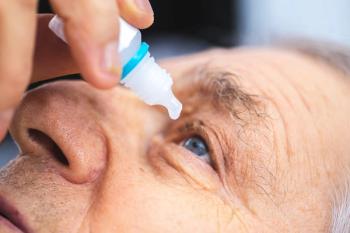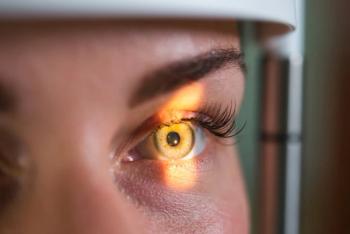
- November/December digital edition 2025
- Volume 17
- Issue 06
Study examines association between air pollutants and dry eye via gene involvement
Dry eye disease is ubiquitous, with up to 20% of middle-aged patients estimated to have moderate to severe symptoms or searching for a treatment.
A recent Chinese study identified the major players (ie, 6 key genes) involved in the mechanisms by which air pollutants influence the development of dry eye,1 reported Yuting Wu, MMED, the lead author of the study, who is from the Department of Ophthalmology, Affiliated People’s Hospital (Fujian Provincial People’s Hospital, Fujian University of Traditional Chinese Medicine, and the Eye Institute of Integrated Chinese and Western Medicine, Fujian University of Traditional Chinese Medicine, both in Fuzhou, China.
Dry eye disease is ubiquitous, with up to 20% of middle-aged patients estimated to have moderate to severe symptoms or to be searching for a treatment.2 In addition to patient age, female sex, genetics, and ethnicity, all of which are definite risk factors for dry eye,2 Wu and colleagues explained that “several studies have concluded that exposure to environmental factors such as airborne pollutants was associated with risk of dry eye outpatient visits.3,4 Since atmospheric pollutants can affect dry eye primarily through necroptosis, autophagy, inflammatory responses, and oxidative stress,5 causing a massive burden to individuals and society, it is imperative to focus on understanding the specific physiopathologic mechanisms involved in order to effectively prevent and manage the onset and progression of this disease.”
Study methods
The investigators conducted a comprehensive search of multiple online databases to determine target genes associated with both air pollutants and dry eye. They explained that they did protein-protein interaction analysis and visualization for the overlapping genes. To determine the potential mechanisms, gene ontology (GO) and Kyoto Encyclopedia of Genes and Genomes (KEGG) functional enrichment analyses were performed.
The investigators used the newest technologies (ie, network toxicology, molecular docking, and molecular dynamics simulation techniques) to reveal the potential association between air pollutants and dry eye, they explained.
The study explained that network toxicology, a branch of network pharmacology, uses network analysis methods to substantiate the toxicity of targeted substances. Molecular docking was defined as “a pivotal molecular simulation technique used to study intermolecular interactions at the atomic level, such as the intercorrelations between ligands, small molecules, and receptor macromolecules. Its core mechanism is built based on simulating spatial and energy matching between molecules, predicting binding patterns and affinity.” Likewise, molecular dynamics simulation was defined as a computational technique grounded in classical mechanics and used to simulate the trajectories of atoms and molecules within molecular systems and analyze their temporal evolution. This method operates on the principle of characterizing the motion state of target particles by solving Newton’s equations of motion, according to the authors.
What did the analyses of the pollutants uncover?
The study analyzed 8 common air pollutants: benzene, sulfur dioxide, ozone, nitric oxide, carbon monoxide, toluene, formaldehyde, and naphthalene.
The analyses identified 26 intersecting targets associated with dry eye.
“Functional enrichment analyses using GO and KEGG pathways indicated that these targets are predominantly involved in biologic processes, including lipid metabolism, hormone regulation, oxidative stress, and inflammatory responses. This analysis underscored 6 pivotal genes linked to air pollutants and dry eye,” Wu and colleagues reported.
The 6 genes are tumor necrosis factor (TNF), EGFR, matrix metallopeptidase-9 and -2 (MMP9, MMP2), estrogen receptor 1 (ESR1), and intercellular adhesion molecule 1 (ICAM1).
In commenting on the study findings, the authors said, “[These genes] may serve as critical ingredients in mediating the relationship between air pollutants and the onset and progression of dry eye. This research offers novel perspectives on the underlying molecular mechanisms by which air pollutants influence dry eye progression in theory and deepens individual understanding of partial responsibility of air pollution on the eye. In addition, these key genes represent promising molecular targets for early prevention, timely assessment of prognosis, and targeted intervention methods for dry eye.… These findings can provide a scientific basis for reducing air pollution release and alleviating ocular surface diseases, possibly, which has important public health significance.”
Regarding real-world considerations, they advised that individuals in highly polluted areas are actually at increased risk for dry eye and should wear wraparound sunglasses to protect their eyes, use indoor air purifiers, and consider preservative-free artificial tears during pollution spikes. Ophthalmologists should ask about air-quality exposure in routine checkups for dry eye symptoms. Dry eye awareness should be included in pollution-alert systems to provide timely warnings and eye-care advice to at-risk groups, they pointed out.
References
Wu Y, Jiao Z, Liu Y, et al. Association between air pollution and dry eye: insights from network toxicology and molecular docking analysis. BMC Pharmacol Toxicol. 2025;26(1):182.
doi:10.1186/s40360-025-00994-0 Britten-Jones AC, Wang MTM, Samuels I, Jennings C, Stapleton F, Craig JP. Epidemiology and risk factors of dry eye disease: considerations for clinical management. Medicina (Kaunas). 2024;60(9):1458. doi:10.3390/medicina60091458
Cao F, Chen Y, Gui YC, et al. Association between traffic-related air pollution and risk of outpatient visits for dry eye disease in a megacity along the subtropical coast in South China. BMC Public Health. 2025;25(1):151. doi:10.1186/s12889-025-21319-0
Chu D, Chen J, Yang C, Li Y, Wang M, Bao J. Associations between air pollution and daily outpatient visits for dry eye disease and the effect modification of temperature. BMC Public Health. 2025;25(1):1163. doi:10.1186/s12889-025-22187-4
Zhou HZ, Liu X, Zhou D, et al. Effects of air pollution and meteorological conditions on DED: associated manifestations and underlying mechanisms. Klin Monbl Augenheilkd. 2024;241(9):1062–1070. doi:10.1055/a-2316-6808
Articles in this issue
23 days ago
The A to Zzzs of ocular health25 days ago
The microbiome in diabetes and DRNewsletter
Want more insights like this? Subscribe to Optometry Times and get clinical pearls and practice tips delivered straight to your inbox.









































